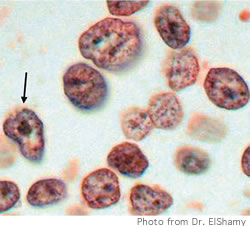Taking the Big Out of the Big C
Dr. Wael ElShamy of the Cancer Research Center of Hawaii is working to make the most deadly cancers - including breast cancer - less dangerous.
By Chad Pata
E-mail this story | Print this page | Archive | RSS |
 Del.icio.us
Del.icio.us
|
asking the right questions,” says ElShamy. “I like the science when it fits. When the theories are supported by the experiment, that is great.”
He began with a natural DNA inhibitor in our bodies named geminin, to which many scientists are looking because, if it naturally prevents the splitting of cells, perhaps it can help stop the cell cycle in cancer. So it has been viewed as a good guy until ElShamy looked further.
What he discovered was that, while in smaller amounts it does prevent the splitting of cells, an over-expression of it can actually have the opposite effect, leading to highly aggressive cells that metastasize to other organs.
This discovery turns all the science on geminin on its ear, and scientists are not creatures who are easily swayed.
“In my field, there is always resistance to anything new,” says ElShamy, who has been working on this particular problem for 18 months now. “They say, ‘Who are you to say this and that?‘But if you produce the data and put it out there and people confirm it, then you can change their minds. And that is what we are trying to do now.”
To put it into layman’s terms, ElShamy says the cancer cells are like a drunk with geminin being their booze - if you take away the booze, the cells go into DTs and will kill themselves. So now the trick is how to inhibit the geminin. Creating a new drug can take 10 to 15 years, but experiments with an already existing drug have had positive results.
“When you treat cancer, you want to kill tumor cells and not normal cells, and that’s exactly what this experiment, at least in cultures, suggests,” says ElShamy. “We have already made some animal models: We reconstituted this experiment in mice and found that if you take away geminin expression from them they cannot form a tumor, and that is very, very important.”

|
Despite the positive strides they have made in the oncological functions of geminin, it is the only lab working on it currently, and secrecy is of the utmost concern. Abreakthrough like this would not only preserve so many lives, but would also generate untold millions of dollars.
“I can get scooped by a bigger lab with more hands that can do it faster,” says ElShamy. “That’s why I have to be the first one to put it out there, because if I am not the first one I cannot get funded and I cannot get the publicity. That’s important for this kind of research, because without the publicity the funds are not there.”
He also has another very important reason for playing his cards close to his chest.
“Also, if I print it in the paper, it can increase the expectations of patients that maybe a drug is coming soon,” says ElShamy. “That hope is false hope for now. I have not saved anybody’s life yet, and that I cannot take. That is why, in my mind, I have to be careful.”
Years of clinical testing lay ahead for ElShamy, and the best bet for beating this cursed disease is still early detection. The survival rate for women once breast cancer has spread is less than 25 percent, but when it is discovered still in the localized stage women are now beating it at a 98 percent rate.
“We can’t control people getting cancer, but we can control their dying of it,” says Young, who readily admits she was not diligent enough in getting checked and now urges others to learn from her mistakes.
“Through early detection, a lot more treatments are available.”
So ElShamy’s work will continue, and if his theories prove out they could play a role in stopping the spread of many other varieties of cancer, not just breast cancer. It may not be the cure to the disease, but stopping the metastization would be a huge step in the right direction.
“Remember, we are dealing 40,000 deaths a year,” says ElShamy. “If we can reduce this number somehow by doing what we are doing here, then it is worthwhile.”
Page 2 of 2 pages for this story < 1 2
E-mail this story | Print this page | Comments (0) | Archive | RSS
Most Recent Comment(s):








